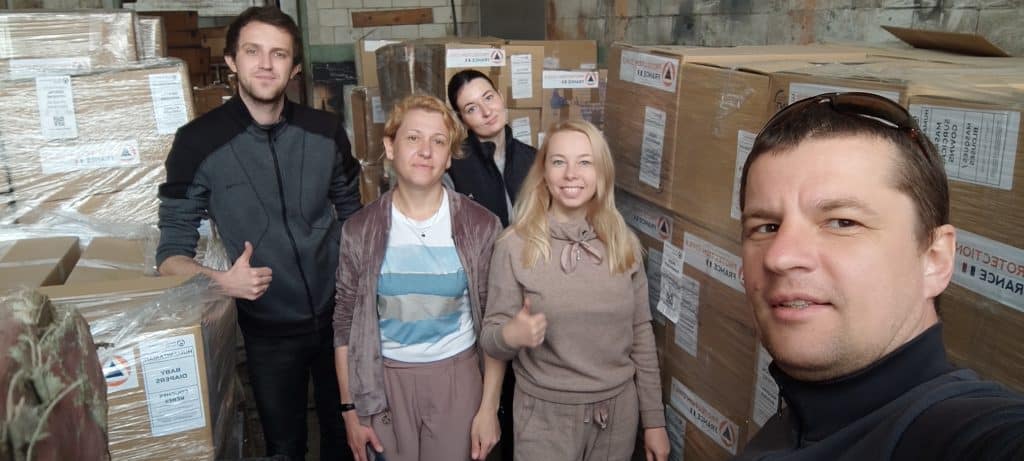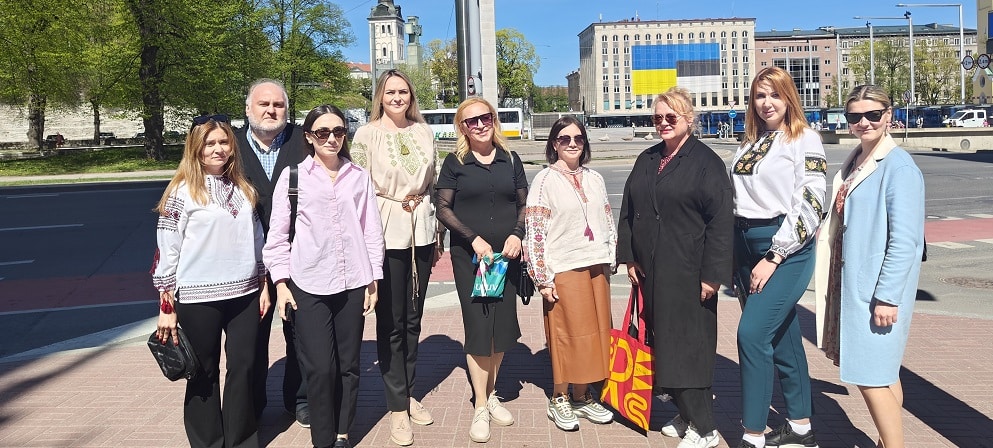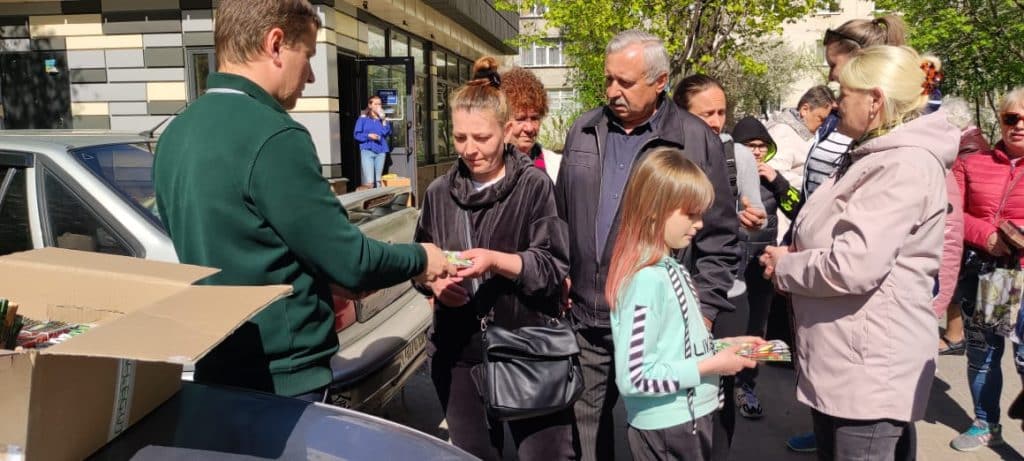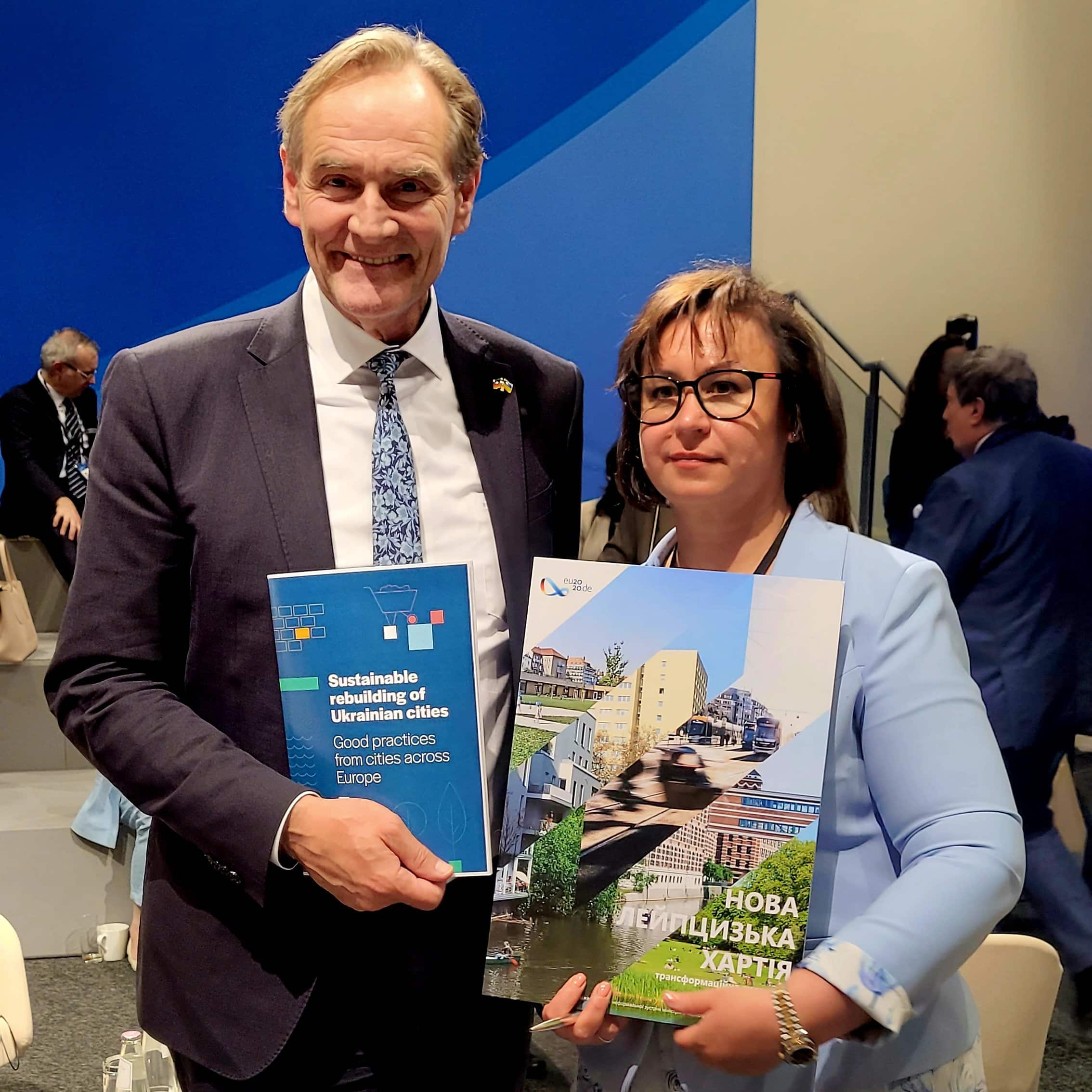Photo Credits: Hitex Charity Fund and Sumy City Council
Reading Time: 10 minutes
Photo Credits: Hitex Charity Fund and Sumy City Council
Ukrainian cities stand strong and look to a sustainable future
As Russia’s war in Ukraine moves well into its fourth year, Ukrainian cities continue to demonstrate extraordinary resilience. Despite relentless bombardment, displacement and destruction, they are not only surviving, they are becoming symbols of hope and determination.
Across the country, mayors, city officials, local businesses and residents are working tirelessly to hold their communities together, protect their citizens, and plan for a European future built on peace, democracy and climate neutrality.
European cities are standing by them, offering solidarity, expertise and long-term cooperation. This alliance is not just about aid, it is a partnership rooted in shared values and common purpose.
As well as this support, European cities are also taking action to ensure Ukraine and other European countries are supported in the EU membership process, and can look forward to a more prosperous and sustainable future for their people.
Cities under fire, but not broken
Few cities reflect Ukraine’s determination as clearly as Kharkiv. Once a thriving academic and industrial hub, it has endured over 300 attacks in the past year. Yet it adapts and rebuilds.
The city is creating decentralised energy systems to power hospitals during blackouts and is rebuilding housing and infrastructure with long-term resilience in mind.
In Khmelnytskyi, the population has surged by 17% as people flee frontline areas. Local businesses and volunteers have stepped in to support displaced families.
Meanwhile, in Poltava, which has also suffered missile attacks, emergency teams deliver aid and provide psychological support.
Our resilience is in our unity. In the way ordinary Kharkiv citizens help each other, in the way utility companies repair networks under fire, and in the way doctors save lives under shelling.
– Ihor Terekhov, Mayor of Kharkiv
Our greatest desire is for our city to be calm again, for children to be able to play on the streets without fear, for people to live in their homes, not afraid of enemy attacks.
– Valeriy Parkhomenko, First Deputy Mayor of Poltava

Staff from the Sumy region prepare to unload boxes of humanitarian aid delivered by Lublin. Photo credits: Hitex Charity Fund and Sumy.
Peace talks must involve Ukraine and the EU
In January 2025, as discussions took place between the United States and Russia on the potential for peace, city leaders in Europe and Ukraine made a unified call: Ukraine and the EU must be at the negotiating table to ensure an outcome that defends respect for the rule of law, fundamental rights and democratic values.
As discussions on the possibility of peace have continued into 2025, the position of Europe’s mayors has not wavered. They continue to call for Ukraine and the EU to play a central role in any peace negotiations that take place.
This united stance reflects the political role cities now play, not only as service providers, but as defenders of democracy.
Europe belongs at the negotiating table. We fight for European values. Ukraine is Europe! Putin and Trump must not negotiate among themselves.
– Vitali Klitschko, Mayor of Kyiv
Mayors champion democracy and the rule of law in Europe and beyond. It is evident that these discussions need to involve Ukraine and the European Union.
– Mathias De Clercq, Mayor of Ghent

Ukrainian cities in the SUN4Ukriane project attend the EU Mission Cities Conference in Vilnius. Photo copyright: NetZeroCities.
Rebuilding starts now
Despite ongoing hostilities, many Ukrainian cities are already laying the groundwork for recovery. They are rethinking urban planning, restoring critical infrastructure, and adopting sustainable practices aligned with EU standards.
In Zhytomyr, a city regularly threatened by missile strikes, the local government is pushing forward with ambitious sustainability goals.
Vinnytsia is leading efforts to modernise mobility, investing in low-emission public transport and resilient infrastructure. Its partnerships with Kielce, Karlsruhe, and Nancy have helped introduce new bus routes, optimise traffic flows, and pilot electric transport solutions.
In Chernihiv, almost entirely destroyed in 2022, the pace of reconstruction has been remarkable. The city has rebuilt schools, hospitals and housing blocks. The city is embedding energy-efficient design into every new building, aligning recovery with long-term climate goals.
We call Chernihiv the City of Heroes. We are rebuilding with courage and vision.
– Nataliia Kholchenkova, Head of International Relations

Meeting between representatives from Tallinn and Vinnytsia. Photo credits: City of Tallinn.
We are planning for green spaces, cycling networks, energy-efficient buildings. We believe our future lies in Europe, and in sustainability.
– Ilona Kolodii, Head of the Zhytomyr Department of Culture
European cities provide support and strategic expertise
Across Europe, cities continue to step up to support their Ukrainian counterparts, forming partnerships, providing resources and offering long-term expertise and strategic support to help Ukrainian cities survive today and prepare for tomorrow.
Beyond material aid, these partnerships, often built through twinning agreements, have delivered real results, offering Ukrainian cities access to invaluable knowledge, expertise and training.
The city of Warsaw has supported the renewal of Kharkiv’s metro system, a critical piece of the city’s mobility network. Oslo has provided funding to Lviv’s St Nicholas Children’s Hospital, and Tallinn has worked with Vinnytsia to co-design circular economy policies and improve waste management.
Strasbourg has taken a strong stance of solidarity. The city hosted 40 middle school students from Kharkiv for a respite stay, offering them a break from the psychological pressure of war.
Chernihiv has signed six new twinning agreements since 2022. Cities like Rzeszow, Aachen and Lappeenranta have provided everything from public transport vehicles to modular housing for displaced families.
This solidarity is more than just practical help – it is a sign that we are already part of the European family.
– Nataliia Kholchenkova, Head of International Relations and Investments Department of Chernihiv City Council

Essential items being handed out to people in the Sumy region. Photo credits: Hitex Charity Fund and Sumy City Council.
Cities’ central role in EU enlargement
As Ukraine and other candidate countries move toward EU membership, European cities have a central role to play, translating EU policies into real change, driving green innovation, and fostering democratic values.
City-to-city partnerships, like those through the SUN4Ukraine project, are supporting Ukrainian cities in designing Climate Neutrality Plans as part of their reconstruction strategies. Eurocities’ capacity-building programme has also connected Ukrainian and European cities to develop sustainable recovery plans.
Despite this progress, cities are often excluded from enlargement processes. Eurocities is calling for city involvement in designing, implementing and monitoring EU reforms, along with stronger financial support.
At the European Mayors Summit in Strasbourg, mayors called for direct funding to cities, including candidate cities, to address centralised EU funding challenges and to consider flexible pathways to membership.
Without adequate support, cities in candidate countries may struggle to implement the complex regulatory frameworks required for EU membership.
– André Sobczak, Secretary General, Eurocities
SUN4Ukraine: Building bridges for a climate-neutral recovery
Launched in May 2024, the SUN4Ukraine project marks a new phase in Ukraine-EU cooperation. Funded by Horizon Europe and coordinated by Eurocities, a consortium of 13 organisations from across EU and Ukraine is helping Ukrainian cities align recovery with climate neutrality.
In December 2024, twelve Ukrainian cities were selected as the project’s Flagship Municipalities: Chernihiv, Chernivtsi, Dnipro, Kalush, Kharkiv, Konotop, Kyiv, Mykolaiv, Novovolynsk, Pervomaisk, Vinnytsia and Zviahel. They will now work with project experts to develop their Climate Neutrality Plans, linking Ukrainian municipalities with the EU Climate-Neutral and Smart Cities Mission.
In May 2025, the project supported in-person participation of the twelve Ukrainian Flagship Municipalities in the Cities Mission Conference in Vilnius, and launched a call for EU Mission Cities to partner with the Ukrainian municipalities for shared learning and innovation in areas such as climate mitigation and adaptation, urban development, energy, transport, waste management, strategic planning and data collection.
We hope that the SUN4Ukraine project will allow us to learn from European experience and strengthen our partnerships with the European community.
– Borys Karpus, Mayor of Novovolynsk
These partnerships foster solidarity and strong regional cooperation.
– Masha Smirnova, Head of Governance at Eurocities

Mayor of Cologne, Henriette Reker, and Mayor of Dnipro, Borys Filatov, sign the twinning agreement between their cities. Photo copyright: City of Cologne Thomas Banneyer.
Sustainable rebuilding of Ukraine’s cities
Eurocities’ two-year-long capacity-building programme for Ukrainian cities supported the development of green, inclusive recovery strategies. Beginning in 2023, 34 EU cities worked with 10 Ukrainian cities, resulting in a toolkit of best practices in both English and Ukrainian. This toolkit was presented at the Ukraine Recovery Conference in Berlin in 2024.
In parallel, Eurocities has been a vocal supporter of the establishment of the Ukraine Facility and called for a strengthened role of cities in its implementation. As part of this wider effort, 20% of the Facility’s funding will be dedicated to the recovery, reconstruction and modernisation needs of Ukrainian sub-national authorities, particularly local governments.
The project’s second phase began in 2024, pairing 21 EU cities with five Ukrainian cities – Dnipro, Kryvyi Rih, Pavlohrad, Pokrovsk and Zaporizhzhia – to co-develop urban strategies and investment proposals for a sustainable recovery. Over the past year, peer-learning, capacity-building workshops and mentoring sessions have focused on urban governance, green procurement, data use and project prioritisation.
This has resulted in a comprehensive set of recommendations to improve Ukrainian urban development strategies, supported by a green criteria checklist co-created with all participating cities.
With the Ukrainian city of Pavlohrad, the project developed an investment plan for the reconstruction of the city’s water intake system, to reduce critical vulnerabilities and improve access and water quality for residents. This plan received a positive appraisal from the European Investment Bank.

At the Ukraine Recovery Conference, Eurocities President Burkhard Jung, shares Eurocities’ urban development practices from cities across Europe.
